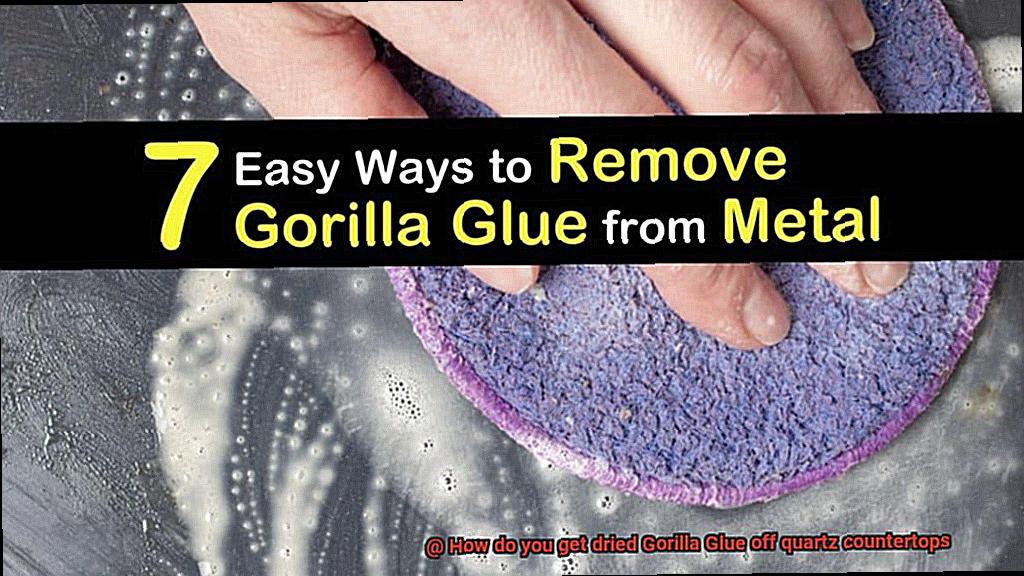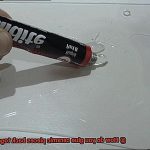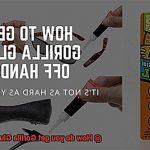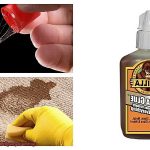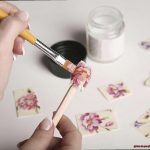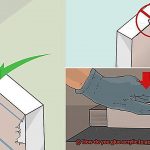Welcome to the dazzling realm of quartz countertops. These magnificent surfaces can transform any kitchen or bathroom into a haven of elegance and style. But, as luck would have it, there are moments when life throws us a curveball, and stubborn adhesives like Gorilla Glue decide to take up residence on our beloved quartz counters. Fear not, my fellow homeowners, for we have stumbled upon the secret formula to liberate your precious countertop from the clutches of dried glue.
Picture this: You’re in the midst of an exhilarating DIY project, only to discover that a stubborn blob of Gorilla Glue has hardened itself onto your cherished quartz counter. Panic ensues, and traditional cleaning methods fall flat on their face. But fret not. This blog post is here to be your knight in shining armor, equipped with expert advice to conquer that unyielding adhesive.
In this captivating journey towards countertop salvation, we will dive deep into the intricate details of successfully removing dried Gorilla Glue from quartz surfaces. From gentle solvents to ingenious techniques, we’ve got an array of tips and tricks up our sleeves that will leave you feeling empowered and ready to rescue your pristine countertops.
But wait, there’s more. We’ll also address those nagging concerns about potential damage while embarking on this glue removal quest. From start to finish, we’ll guide you through every step, ensuring that your countertop’s radiance is restored and its beauty shines brighter than ever before.
So buckle up and prepare yourself for an extraordinary adventure as we unlock the secrets of bidding farewell to dried Gorilla Glue on your treasured quartz countertop. Get ready to be amazed as we unveil the steps for a triumphant rescue operation that will have your countertop looking flawless in no time at all.
Understanding the Properties of Gorilla Glue
Contents
- 1 Understanding the Properties of Gorilla Glue
- 2 Preparing for Removal
- 3 Scraping Off the Dried Glue
- 4 Using Acetone to Dissolve the Glue
- 5 Isopropyl Alcohol as an Alternative
- 6 Using Warm Water and Soap to Remove the Glue
- 7 Natural Alternatives such as Vinegar
- 8 Testing Products and Methods on a Small Area First
- 9 Conclusion
Gorilla Glue is renowned for its exceptional strength and durability, making it a popular choice for household and DIY projects. From bonding wood to metal, ceramic to quartz countertops, this adhesive is versatile and efficient.
However, removing dried Gorilla Glue from quartz surfaces requires a delicate approach to preserve their integrity. Let’s delve into the unique properties of Gorilla Glue and how they impact the removal process.
One standout characteristic of Gorilla Glue is its ability to expand when exposed to moisture. This expansion creates a robust bond between surfaces, but it can complicate the removal of dried glue from quartz countertops. Unlike water-soluble adhesives, Gorilla Glue is polyurethane-based and necessitates a different strategy for successful removal.
When addressing dried Gorilla Glue on quartz countertops, it is paramount to avoid using abrasive tools or harsh chemicals that may harm the surface. Instead, opt for gentle yet effective methods that will safely remove the glue without compromising the countertop’s appearance.
Firstly, employing heat can soften dried Gorilla Glue, facilitating easier removal. Carefully apply heat to the glue using a heat gun or hairdryer on low heat settings. The softened glue can then be gently scraped off with a plastic scraper or putty knife. Exercise caution to prevent overheating or discoloration of the quartz surface.
Alternatively, specialized adhesive removers can be highly effective in dissolving dried Gorilla Glue without causing damage. Follow the manufacturer’s instructions precisely and conduct a patch test on an inconspicuous area before applying the remover to the glue. These removers are designed to break down adhesives while preserving the countertop’s integrity.
During the removal process, patience is key as it may require multiple attempts and persistent effort to completely eliminate dried Gorilla Glue from quartz countertops. Use a plastic scraper or putty knife to gently scrape off the softened glue, ensuring no scratching or damage occurs.
Once the dried Gorilla Glue has been successfully removed, it is advisable to clean the countertop with a mild soap and water solution to eliminate any residue from the adhesive remover or scraping process.
Preparing for Removal
Take a deep breath, because I’ve got your back. This article will guide you through the crucial steps you need to take to prepare for the removal process. It’s all about safeguarding your countertop and gathering the necessary supplies before diving in.
First and foremost, let’s talk about protecting your precious countertop. We don’t want any accidental damage or unsightly scratches, so grab some masking tape or painter’s tape and create a sturdy barrier along the edges. This simple yet effective step will ensure that your countertop remains flawless throughout the removal process.
Now, let’s gather the tools of the trade for this mission. You’ll need a trusty plastic scraper or putty knife, some rubbing alcohol or acetone, a soft cloth or sponge, and perhaps even a gentle cleaning solution specifically designed for quartz countertops. Having these essential supplies within arm’s reach will make your life so much easier when it’s time to tackle that stubborn dried Gorilla Glue.
But before you jump into action, let’s run a little test. Apply a small amount of your chosen solvent or cleaning solution on a hidden area of the quartz countertop. We want to make absolutely sure that it won’t cause any unsightly discoloration or damage. Once you’ve waited a few minutes and everything looks good, you can proceed with confidence, knowing that you’ve chosen the right product.
Now here’s a nifty trick that can save you some elbow grease – warm up that stubborn dried Gorilla Glue using a hairdryer set on low heat. The gentle warmth will work its magic and soften the glue, making removal a breeze. Just remember to exercise caution and avoid overheating or damaging the delicate quartz surface.
Finally, it’s time for the grand finale. Armed with your trusty plastic scraper or putty knife, apply gentle pressure as you carefully scrape off as much of the dried Gorilla Glue as possible. Remember, we’re aiming for a flawless countertop, so steer clear of excessive force or sharp tools that could leave scratches or damage. Patience and a steady hand are your secret weapons here.
Scraping Off the Dried Glue
Quartz countertops are a sight to behold, but when dried Gorilla Glue becomes an unwelcome guest, it’s time to unleash your inner craftsman. Prepare to embark on a thrilling journey as we delve into the secrets of scraping off that stubborn glue and restoring your countertop’s pristine beauty. So, grab your plastic scraper and putty knife, for we are about to conquer the art of removing dried glue from quartz countertops.
Step 1: The Power of Patience
Step 2: Arm Yourself with the Right Tools
In this battle against dried glue, our weapons of choice are the plastic scraper and putty knife with a flat edge. These tools possess the finesse required to remove the glue without leaving a trace of damage or scratches on the quartz surface. Ensure these trusty companions are within arm’s reach before embarking on this daring adventure.
Step 3: Let the Scrape-tivation Begin.
With your weapons in hand, it’s time to unleash your scraping prowess. Apply gentle pressure on one edge of the dried Gorilla Glue. As you slide the tool underneath, watch in awe as the glue lifts away from the countertop surface. Remember, steady and controlled motions are our guiding principles in preventing any accidental damage.
Step 4: Heat it up.
But what about those stubborn remnants that refuse to yield? Fear not, for we have a secret weapon – heat. Channel the power of a hairdryer set on low heat or a heat gun at a safe distance to warm up the glue. The gentle warmth will soften its grip, making it easier to scrape off. However, exercise caution and avoid overheating or damaging the quartz surface in the process.
Using Acetone to Dissolve the Glue
Today, we embark on an extraordinary journey into the realm of acetone, a formidable solvent capable of vanquishing even the most stubborn Gorilla Glue residue from your pristine quartz countertops. But before we plunge headfirst into this exhilarating quest, let us arm ourselves with knowledge and precautions. Don your gloves and join me as we unlock the secrets of using acetone to dissolve glue.
Harnessing the Mighty Acetone:
Acetone is no ordinary solvent – it possesses an awe-inspiring power that can dissolve dried Gorilla Glue from your quartz countertops with almost magical precision. However, bear in mind that this potent chemical demands respect and caution.
Fortify Your Defenses:
Before embarking on your adhesive-banishing adventure, ensure your safety by donning gloves and working in a well-ventilated area. We want you to emerge victorious without any harm to yourself or your cherished countertop.
A Test of Compatibility:
No fearless adventurer charges into battle without first scouting the terrain. Similarly, before unleashing acetone upon your countertop, perform a small-scale test in an inconspicuous area to confirm its compatibility and prevent any unwanted damage or discoloration. Remember: better safe than sorry.
The Dance of Dabbing:
Armed with a pristine cloth or sponge, immerse it in acetone and commence the mesmerizing dance of dabbing onto the dried glue. Allow the acetone to permeate the adhesive’s defenses by granting it a few minutes to work its enchantment. We seek nothing less than total surrender.
Scrape with Grace, Spare No Trace:
Once the acetone has been granted ample time to showcase its prowess, wield a plastic scraper or credit card with utmost finesse to delicately scrape away the dissolved glue. Beware the treacherous metal tools, for they may mar your countertop’s flawless beauty. Our goal is restoration, not blemish.
Persistence Prevails:
Even the most formidable warriors sometimes require a second assault. Should any stubborn remnants of glue persist, fear not. Repeat the process until every last vestige of adhesive has been eradicated. Remember, persistence paves the path to triumph.
Isopropyl Alcohol as an Alternative
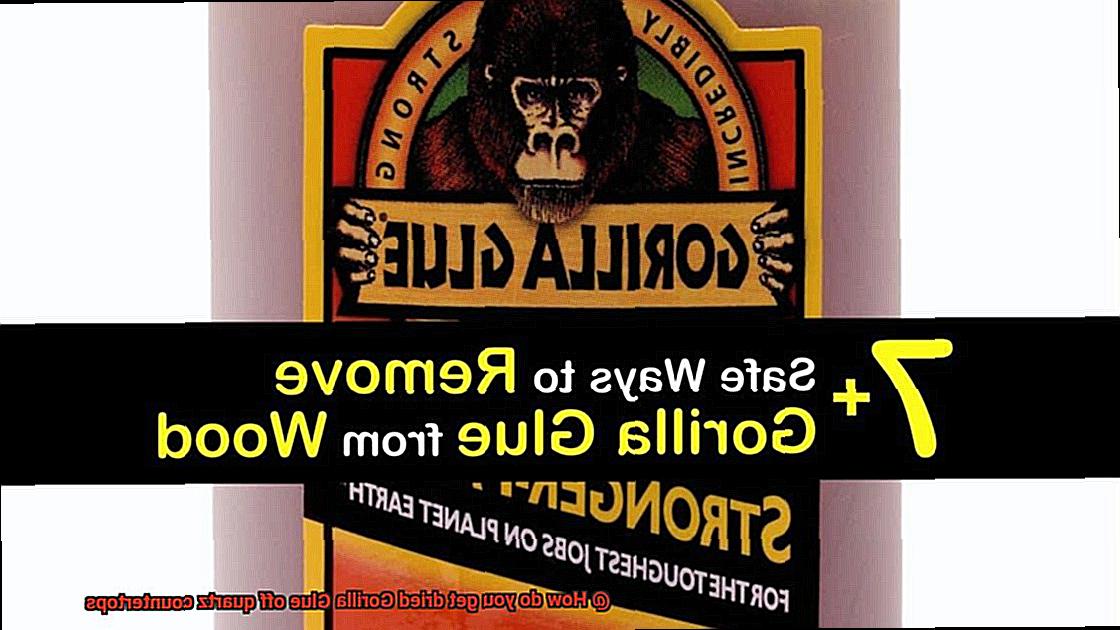
Today, we embark on an exciting journey to discover the magic of isopropyl alcohol as the ultimate superhero in removing dried Gorilla Glue from your quartz countertops. While acetone has its place in this adventure, we’ll explore the gentler side of glue removal with this versatile solvent. Prepare to be amazed as we uncover the secrets of isopropyl alcohol and restore your countertop’s pristine beauty.
Isopropyl Alcohol: Unleashing Its Power:
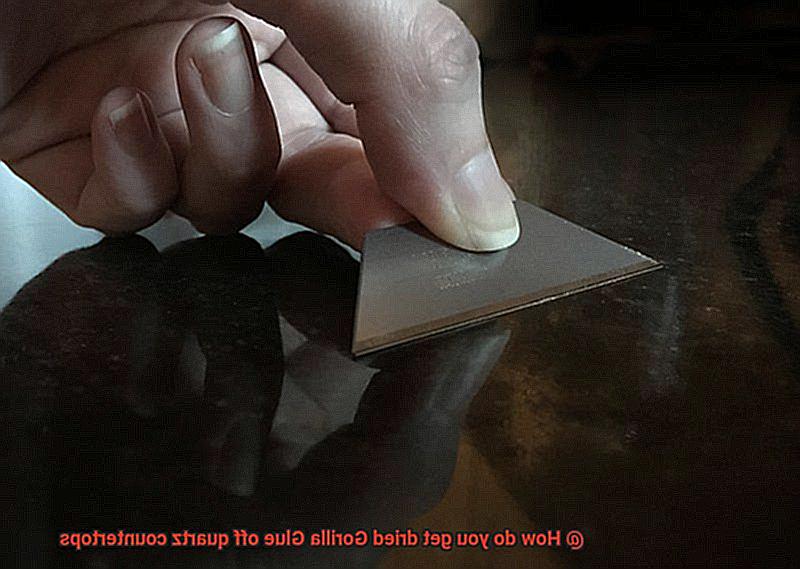
Isopropyl alcohol, also known as rubbing alcohol, is a household champion when it comes to banishing pesky dried Gorilla Glue from your beloved quartz countertops. Its secret lies in its ability to break down the adhesive properties of the glue, making it a formidable opponent against those stubborn remnants.
Safety First: A Necessary Precaution:
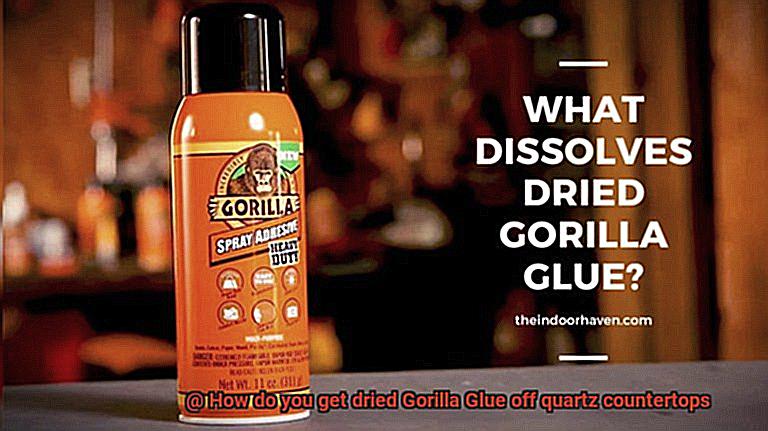
Before you dive into the world of isopropyl alcohol, it’s crucial to conduct a small test on an inconspicuous area of your countertop. This ensures that the alcohol won’t cause any damage or discoloration. After all, precaution is the foundation of success.
The Dance Begins: Unveiling the Technique:
To initiate our adhesive-banishing ritual, pour a small amount of isopropyl alcohol onto a clean cloth or sponge. With gentle strokes, apply this magical elixir to the dried Gorilla Glue and let it sit for a few minutes. Observe in awe as the alcohol works its magic, delicately softening the glue and preparing it for removal.
The Art of Removal: A Delicate Touch:
Once the glue has been softened by isopropyl alcohol, it’s time to delicately scrape or brush it away. Choose a plastic scraper or a soft-bristle brush to safeguard your exquisite countertop surface from any scratches or damage. With finesse and determination, bid farewell to that glue.
The Final Touch: Persistence Pays Off:
If a few stubborn traces of glue persist, don’t lose heart. Simply repeat the process until your countertop is completely free of any lingering residue. Remember, persistence is the key to victory in this battle against the remnants of Gorilla Glue.
Using Warm Water and Soap to Remove the Glue
Picture this: a pristine quartz countertop, marred by the unsightly presence of dried glue. But fret not, for there is a hero in our midst – the dynamic duo of warm water and soap. Together, they possess the superpower to banish glue gunk and restore your countertops to their former glory. So tighten your cleaning capes and prepare for an adventure as we delve into the transformative potential of warm water and soap.
Gather Your Arsenal:
Before embarking on your mission, prepare your trusty tools: a clean cloth or sponge, warm water (not scalding hot.), mild dish soap or hand soap, and an unwavering spirit of determination.
Soak and Engage:
Take a moment to soak your cloth or sponge in the comforting embrace of warm water. A gentle wringing ensures the perfect balance – not too wet, not too dry – just enough to tackle the task at hand.
Apply Delicate Pressure:
Armed with your damp cloth, proceed to caress the affected area with precise strokes, applying gentle pressure. The warmth of the water envelops the glue, coaxing it to relinquish its hold on your countertop’s surface.
Summons the Reinforcements:
In some battles, even gentle persuasion may not suffice. Fear not, for mild dish soap or hand soap are here to lend their mighty strength. Bestow a modest amount of soap upon your cloth or sponge and continue your assault on the adhesive. Witness as it succumbs to the cleansing power of soap’s secret weapon.
Rinse and Repeat (if Necessary):
As our victory draws near, rinse away any traces of soap residue with clean water. Take a moment to assess the battlefield – should any lingering vestiges of glue remain, fear not. Merely repeat the process until your countertop stands liberated from its sticky nemesis.
Tread with Caution:
Quartz, though resilient, deserves our tender respect. Eschew excessive scrubbing and abrasive cleaners, for they pose a threat to your countertop’s well-being. Remember, a gentle touch and the harmonious dance of warm water and soap are our allies in this endeavor.
Natural Alternatives such as Vinegar
Don’t worry, we’ve got the perfect sidekick to help you defeat the stubborn Gorilla Glue and restore your quartz countertops to their former glory. Introducing vinegar, the natural and cost-effective solution that will save the day.
Vinegar’s secret weapon is none other than acetic acid, a powerful compound known for its ability to break down tough substances like dried Gorilla Glue. But how exactly do you harness the power of vinegar to conquer this adhesive menace? Let’s dive in.
First, arm yourself with a clean cloth or sponge and immerse it in undiluted white vinegar. No need to dilute this superhero solution – it’s ready for action straight from the bottle. Once your trusty sidekick is soaked, place it directly onto the dried Gorilla Glue and let it work its magic for approximately 30 minutes. During this time, the vinegar will begin to dissolve the glue, making it softer and more pliable.
After the countdown is over, it’s time to engage in some serious scrubbing. Grab a soft-bristled brush or sponge and gently scrub the area to loosen the now pliable glue. If necessary, you can reapply vinegar and repeat the process until every trace of glue is vanquished.
With the Gorilla Glue defeated, wipe away any remaining residue using a clean, damp cloth. Your countertops will shine once again, thanks to vinegar’s incredible powers.
But before you embark on this epic cleaning adventure, a word of caution: vinegar may not be effective against all types of glue. To avoid any unwanted surprises, test vinegar on a small, inconspicuous area of your quartz countertop before going all-in on the battle.
And there’s one more thing to consider: the smell. Vinegar does have a potent odor that some may find unpleasant. If you’re sensitive to smells or prefer a different aroma in your cleaning quests, don’t fret. There are plenty of other natural alternatives for tackling dried Gorilla Glue.
Testing Products and Methods on a Small Area First
If you’ve found yourself in a sticky situation with dried Gorilla Glue on your stunning quartz countertops, fear not. I’m here to unveil the secret weapon that will ensure a successful glue removal mission – testing products and methods on a small area first. This precautionary step is your knight in shining armor, protecting your precious surface from potential disasters. So, let’s dive into the world of small area testing and discover how it can save the day.
Delicate Quartz Countertops Demand Caution:
Ah, quartz countertops, a delicate beauty that requires gentle treatment. Harsh chemicals and abrasive tools are their arch-nemeses, capable of causing irreversible damage or unsightly discoloration. That’s why testing is non-negotiable. It’s your shield against disaster.
Choosing the Perfect Test Zone:
Now, where should we embark on our testing adventure? Seek out an inconspicuous area – behind an appliance or in a discreet corner – where any potential harm won’t be easily noticeable. This secret hideaway allows you to evaluate effectiveness without compromising the entire surface.
Embrace the Manufacturer’s Wisdom:
Before diving headfirst into glue removal, take a moment to acquaint yourself with the manufacturer’s instructions. Each product or method may have its unique application time and technique. By following their guidance, you’ll avoid any unnecessary hiccups along the way.
Inspect and Observe, the Detective’s Duties:
Once the allotted time has passed, it’s time for some detective work. Examine the test area closely, searching for any signs of damage or discoloration. If all looks well, proceed with confidence. However, if any negative changes emerge, halt immediately to prevent further harm.
Different Glues, Different Strategies:
Gorilla Glue is no ordinary adhesive, and you need the right strategy to tackle it. Small area testing allows you to evaluate the effectiveness of your chosen solution specifically for removing dried Gorilla Glue. This tailored approach ensures efficient and safe glue removal without compromising the countertop’s integrity.
4mOgi0_cQCw” >
Conclusion
Removing dried Gorilla Glue from quartz countertops can be a daunting task, but fear not. With the right approach and a little elbow grease, you’ll have your countertops looking pristine in no time. Here are some tried-and-true methods to tackle this sticky situation:
Begin by scraping off any excess glue with a plastic scraper or putty knife. Be careful not to scratch the surface of your quartz countertop.
Next, soak a clean cloth in warm, soapy water and gently rub the affected area. The warmth will help soften the glue, making it easier to remove.
If the glue persists, try using isopropyl alcohol or acetone on a soft cloth. These solvents are effective at breaking down adhesive properties and should be used sparingly.
For stubborn spots, consider using a razor blade at a shallow angle to carefully scrape away the dried glue. Take caution not to apply too much pressure or damage your countertop.
Once the glue is removed, rinse the area thoroughly with water and dry it with a clean towel.
Remember, prevention is key. To avoid future mishaps, protect your quartz countertops by using cutting boards and trivets for hot items.
In conclusion, removing dried Gorilla Glue from quartz countertops requires patience and attention to detail. By following these steps and taking proper precautions, you can restore the beauty of your countertops without causing any damage.

